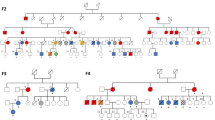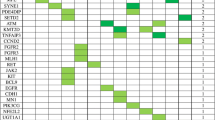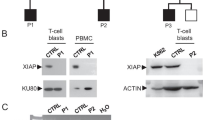Abstract
Objective
Disorders linked to mutations in the X chromosomes typically affect males. The aim of the study is to decipher the mechanism of disease expression in a female patient with a heterozygous mutation on the X-chromosome.
Patients and Methods
Clinical data was extracted from the Canadian Inherited Marrow Failure Registry. Genomic ribonucleic acid (DNA) and complementary DNA (cDNA) underwent Sanger sequencing. Protein analysis was performed by flow cytometry. X-inactivation patterns were analyzed by evaluating the DNA methylation status and cDNA clonal expression of several genes on the X-chromosome. SNP array was used for molecular karyotyping of the X-chromosome.
Results
A female with thrombocytopenia, eczema and mild T-lymphocyte abnormalities with extensive negative diagnostic testing, was suspected to have Wiskott-Aldrich syndrome (WAS)/X-linked thrombocytopenia. Although the girl had a mutation (c.397G > A, p.E133K) in only one allele, she was found to have an extremely skewed X-inactivation pattern and no expression of the WAS protein. Family studies using DNA methylation analysis and cDNA clonal expression of several genes on the X-chromosome demonstrated that the patient developed de-novo non-random inactivation of the X-chromosome that does not carry the mutation. Genome-wide high-density molecular karyotyping excluded deletions and amplifications as a cause for the non-random inactivation of one X-chromosome.
Conclusions
Our study emphasizes the need to test selected female patients with complete or incomplete disease expression for X-linked disorders even in the absence of a family history.

Similar content being viewed by others
References
Remold-O’Donnell E, Rosen FS, Kenney DM. Defects in Wiskott-Aldrich syndrome blood cells. Blood. 1996;87:2621–31.
Ochs HD, Filipovich AH, Veys P, Cowan MJ, Kapoor N. Wiskott-Aldrich syndrome: diagnosis, clinical and laboratory manifestations, and treatment. Biol Blood Marrow Transplant. 2009;15(1 Suppl):84–90.
Notarangelo LD, Miao CH, Ochs HD. Wiskott-Aldrich syndrome. Curr Opin Hematol. 2008;15:30–6.
Wiskott A. Familiarer, angeborener morbus werlhofii? Monatsschr Kinderheilkd. 1937;68:212–6.
Aldrich RA, Steinberg AG, Campbell DC. Pedigree demonstrating a sex-linked recessive condition characterized by draining ears, eczematoid dermatitis and bloody diarrhea. Pediatrics. 1954;13:133–9.
Derry JM, Ochs HD, Francke U. Isolation of a novel gene mutated in Wiskott-Aldrich syndrome. Cell. 1994;78:635–44.
Symons M, Derry JM, Karlak B, Jiang S, Lemahieu V, Mccormick F, et al. Wiskott-Aldrich syndrome protein, a novel effector for the GTPase CDC42Hs, is implicated in actin polymerization. Cell. 1996;84:723–34.
Snapper SB, Rosen FS. The Wiskott-Aldrich syndrome protein (WASP): roles in signaling and cytoskeletal organization. Annu Rev Immunol. 1999;17:905–29.
Villa A, Notarangelo L, Macchi P, Mantuano E, Cavagni G, Brugnoni D, et al. X-linked thrombocytopenia and Wiskott-Aldrich syndrome are allelic diseases with mutations in the WASP gene. Nat Genet. 1995;9:414–7.
Zhu Q, Zhang M, Blaese RM, Derry JM, Junker A, Francke U, et al. The Wiskott-Aldrich syndrome and X-linked congenital thrombocytopenia are caused by mutations of the same gene. Blood. 1995;86:3797–804.
Wengler G, Gorlin JB, Williamson JM, Rosen FS, Bing DH. Nonrandom inactivation of the X chromosome in early lineage hematopoietic cells in carriers of Wiskott-Aldrich syndrome. Blood. 1995;85:2471–7.
Ariga T, Yamada M, Wada T, Saitoh S, Sakiyama Y. Detection of lymphocytes and granulocytes expressing the mutant WASP message in carriers of Wiskott-Aldrich syndrome. Br J Haematol. 1999;104:893–900.
Ochs HD, Slichter SJ, Harker LA, Von Behrens WE, Clark RA, Wedgwood RJ. The Wiskott–Aldrich Syndrome: studies of lymphocytes, granulocytes, and platelets. Blood. 1980;55:243–52.
Jin Y, Mazza C, Christie JR, Giliani S, Fiorini M, Mella P, et al. Mutations of the Wiskott-Aldrich syndrome protein (WASP): hotspots, effect on transcription, and translation and phenotype/genotype correlation. Blood. 2004;104:4010–9.
Kolomietz E, Godbole K, Winsor EJ, Stockley T, Seaward G, Chitayat D. Functional disomy of Xp: prenatal findings and postnatal outcome. Am J Med Genet A. 2005;134(4):393–8.
Swierczek SI, Agarwal N, Nussenzveig RH, Rothstein G, Wilson A, Artz A, et al. Hematopoiesis is not clonal in healthy elderly women. Blood. 2008;112:3186–93.
Nussenzveig RH, Swierczek SI, Jelinek J, Gaikwad A, Liu E, Verstovsek S, et al. Polycythemia vera is not initiated by JAK2V617F mutation. Exp Hematol. 2007;35:32–8.
Dror Y, Squire J, Durie P, Freedman MH. Malignant myeloid transformation with isochromosome 7q in Shwachman-Diamond syndrome. Leukemia. 1998;12:1591–5.
Redon R, Ishikawa S, Fitch KR, Feuk L, Perry GH, Andrews TD, et al. Global variation in copy number in the human genome. Nature. 2006;444:444–54.
Grunebaum E, Mazzolari E, Porta F, Dallera D, Atkinson A, Reid B, et al. Bone marrow transplantation for severe combined immune deficiency. JAMA. 2006;295:508–18.
Ochs HD. Mutations of the Wiskott-Aldrich Syndrome Protein affect protein expression and dictate the clinical phenotypes. Immunol Res. 2009;44:84–8.
Sullivan KE, Mullen CA, Blaese RM, Winkelstein JA. A multiinstitutional survey of the Wiskott–Aldrich Syndrome. J Pediatr. 1994;125:876–85.
Park JY, Kob M, Prodeus AP, Rosen FS, Shcherbina A, Remold-O’Donnell E. Early deficit of lymphocytes in Wiskott-Aldrich syndrome: possible role of WASP in human lymphocyte maturation. Clin Exp Immunol. 2004;136:104–10.
Wada T, Schurman SH, Garabedian EK, Yachie A, Candotti F. Analysis of T-cell repertoire diversity in Wiskott-Aldrich syndrome. Blood. 2005;106:3895–7.
Lyon MF. Gene action in the X-chromosome of the mouse (Mus musculus L.). Nature. 1961;190:372–3.
Lacout C, Haddad E, Sabri S, Svinarchouk F, Garçon L, Capron C, et al. A defect in hematopoietic stem cell migration explains the nonrandom X-chromosome inactivation in carriers of Wiskott-Aldrich syndrome. Blood. 2003;102:1282–9.
Parolini O, Ressmann G, Haas OA, Pawlowsky J, Gadner H, Knapp W, et al. X-linked Wiskott-Aldrich syndrome in a girl. N Engl J Med. 1998;338:291–5.
Andreu N, Pujol-Moix N, Martinez-Lostao L, Oset M, Muñiz-Diaz E, Estivill X, et al. Wiskott-Aldrich syndrome in a female with skewed X-chromosome inactivation. Blood Cells Mol Dis. 2003;31:332–7.
Lanzi G, Moratto D, Vairo D, Masneri S, Delmonte O, Paganini T, et al. A novel primary human immunodeficiency due to deficiency in the WASP-interacting protein WIP. J Exp Med. 2012;209:29–34.
Financial Disclosure
The authors acknowledge the support to this work from the C17 Council and the support they receive from Childhood Cancer Canada, and Coast to Coast Against Cancer Foundation, the Nicola’s Kids Triathlon and Canadian Institute for Health Research (funding reference 102528).
Conflict of Interest
The authors have no conflicts of interest relevant to this article to disclose.
Author information
Authors and Affiliations
Corresponding author
Additional information
Contributor’s Statement
BB designed and performed experiments, analyzed data, wrote the manuscript; SD designed and performed experiments, analyzed data, wrote the manuscript; FAA design laboratory investigation; BZ analyzed data, wrote the manuscript; EG performed experiments, analyzed data, wrote the manuscript; CMR designed experiments; LS designed and performed experiments; SM design laboratory investigation, data interpretation; VB design laboratory investigation, SWS provided control data and technical support, SS performed experiments, JP designed experiments, QZ designed experiments, TRT designed experiments, HDO, designed experiments, analyzed data, wrote the manuscript; YD conceived and designed research, analyzed data and wrote the paper.
Boonchai Boonyawat and Santhosh Dhanraj contributed equally to the work.
Rights and permissions
About this article
Cite this article
Boonyawat, B., Dhanraj, S., al Abbas, F. et al. Combined De-Novo Mutation and Non-Random X-Chromosome Inactivation Causing Wiskott-Aldrich Syndrome in a Female with Thrombocytopenia. J Clin Immunol 33, 1150–1155 (2013). https://doi.org/10.1007/s10875-013-9927-9
Received:
Accepted:
Published:
Issue Date:
DOI: https://doi.org/10.1007/s10875-013-9927-9




